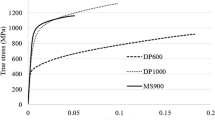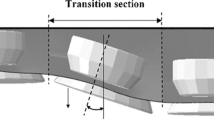Abstract
Flexible Roll Forming (FRF) allows the forming of components with a variable cross section along the length of the component. However, the process has only limited application in the automotive industry due to wrinkling in the flange which currently prevents the forming of high strength steels and limits the part shape complexity. This paper presents a new forming technology, Incremental Shape Rolling (ISR), where a pre-cut blank is clamped between two dies, and then a single forming roll is used to incrementally form the material to the desired shape. The new process is similar to some Incremental Sheet Forming (ISF) approaches but with the difference that Incremental Shape Rolling (ISR) allows the manufacture of longitudinal components from high strength metal sheets. In this work, a numerical model of the ISR of a straight section is developed. Experimental prototyping trials are performed and are used to validate the numerical model which is then applied to analyse the new forming process. The results show that in ISR, tensile residual strains are developed in the flange. Flange wrinkling is observed and directly linked to the number of forming passes that are used in the process.























Similar content being viewed by others
Availability of data and material
Not applicable.
Code availability
Not applicable.
References
Baluch N, Udin ZM, Abdullah CS (2014) Advanced high strength steel in auto industry: an overview. Eng Technol Appl Sci Res 4(4):686–690
Sun G, Deng M, Zheng G et al (2019) Design for cost performance of crashworthy structures made of high strength steel. Thin-Walled Struct 138:458–472. https://doi.org/10.1016/j.tws.2018.07.014
Abeyrathna B, Rolfe B, Weiss M (2017) The effect of process and geometric parameters on longitudinal edge strain and product defects in cold roll forming. Int J Adv Manuf Technol 92(1–4):743–754. https://doi.org/10.1007/s00170-017-0164-x
Paralikas J, Salonitis K, Chryssolouris G (2008) Investigation of the effects of main roll-forming process parameters on quality for a V-section profile from AHSS. Int J Adv Manuf Technol 44(3–4):223–237. https://doi.org/10.1007/s00170-008-1822-9
Deole AD, Barnett MR, Weiss M (2018) The numerical prediction of ductile fracture of martensitic steel in roll forming. Int J Solids Struct 144–145:20–31. https://doi.org/10.1016/j.ijsolstr.2018.04.011
Jiao-Jiao C, Jian-Guo C, Qiu-Fang Z et al (2020) A novel approach to springback control of high-strength steel in cold roll forming. Int J Adv Manuf Technol 107(3–4):1793–1804. https://doi.org/10.1007/s00170-020-05154-8
Jiao J, Rolfe B, Mendiguren J et al (2016) An analytical model for web-warping in variable width flexible roll forming. Int J Adv Manuf Technol 86(5–8):1541–1555. https://doi.org/10.1007/s00170-015-8191-y
Yan Y, Wang H, Li Q et al (2014) Simulation and experimental verification of flexible roll forming of steel sheets. Int J Adv Manuf Technol 72(1–4):209–220. https://doi.org/10.1007/s00170-014-5667-0
Kasaei MM, Naeini HM, Abbaszadeh B et al (2014) Flange wrinkling in flexible roll forming Process. Procedia Eng 81:245–250. https://doi.org/10.1016/j.proeng.2014.09.158
Woo YY, Han SW, Oh IY et al (2019) Shape defects in the flexible roll forming of automotive parts. Int J Automot Technol 20(2):227–236. https://doi.org/10.1007/s12239-019-0022-y
Jiao JS, Rolfe B, Mendiguren J et al (2015) An analytical approach to predict web-warping and longitudinal strain in flexible roll formed sections of variable width. Int J Mech Sci 90:228–238. https://doi.org/10.1016/j.ijmecsci.2014.11.010
Woo YY, Han SW, Hwang TW et al (2018) Characterization of the longitudinal bow during flexible roll forming of steel sheets. J Mater Process Technol 252:782–794. https://doi.org/10.1016/j.jmatprotec.2017.10.048
Kim JH, Woo YY, Hwang TW et al (2016) Effect of loading pattern on longitudinal bowing in flexible roll forming. J Mech Sci Technol 30(12):5633–5639. https://doi.org/10.1007/s12206-016-1132-3
Rezaei R, Moslemi Naeini H, Tafti RA et al (2017) Effect of bend curve on web warping in flexible roll formed profiles. Int J Adv Manuf Technol 93(9–12):3625–3636. https://doi.org/10.1007/s00170-017-0784-1
Kasaei MM, Naeini HM, Liaghat GH et al (2015) Revisiting the wrinkling limits in flexible roll forming. J Strain Anal Eng Des 50(7):528–541. https://doi.org/10.1177/0309324715590956
Groche P, Zettler A, Berner S et al (2010) Development and verification of a one-step-model for the design of flexible roll formed parts. IntJ Mater Form 4(4):371–377. https://doi.org/10.1007/s12289-010-0998-3
Abeyrathna B, Ghanei S, Rolfe B et al (2022) Optimising part quality in the flexible roll forming of an automotive component. Int J Adv Manuf Tech 118(9–10):3361–3373. https://doi.org/10.1007/s00170-021-08176-y
Jia Z, Li L, Han ZR et al (2018) Experimental study on wrinkle suppressing in multi-pass drawing spinning of 304 stainless steel cylinder. Int J Adv Manuf Technol 100(1–4):111–116. https://doi.org/10.1007/s00170-018-2712-4
Wong CC, Dean TA, Lin J (2003) A review of spinning, shear forming and flow forming processes. Int J Mach Tools Manuf 43(14):1419–1435. https://doi.org/10.1016/s0890-6955(03)00172-x
Wang L, Long H (2011) Investigation of material deformation in multi-pass conventional metal spinning. Mater Des 32(5):2891–2899. https://doi.org/10.1016/j.matdes.2010.12.021
Music O, Allwood JM, Kawai K (2010) A review of the mechanics of metal spinning. J Mater Process Technol 210(1):3–23. https://doi.org/10.1016/j.jmatprotec.2009.08.021
Behera AK, de Sousa RA, Ingarao G et al (2017) Single point incremental forming: an assessment of the progress and technology trends from 2005 to 2015. J Manuf Process 27:37–62. https://doi.org/10.1016/j.jmapro.2017.03.014
Kumar A, Gulati V, Kumar P et al (2019) Forming force in incremental sheet forming: a comparative analysis of the state of the art. J Braz Soc Mech Sci Eng 41(6). https://doi.org/10.1007/s40430-019-1755-2
Yoon SJ, Yang DY (2005) An incremental roll forming process for manufacturing doubly curved sheets from general quadrilateral sheet blanks with enhanced process features. CIRP Ann 54(1):221–224
Shim DS, Yang DY, Kim KH et al (2010) Investigation into forming sequences for the incremental forming of doubly curved plates using the line array roll set (LARS) process. Int J Mach Tools Manuf 50(2):214–218. https://doi.org/10.1016/j.ijmachtools.2009.11.009
Standrad A (2016) Standard test methods for tension testing of metallic materials. edn: ASTM International, 2016
Murugesana M, Sajjadb M, Jung DW (2020) Experimental and numerical investigation of cold roll forming process. Mater Sci Eng. https://doi.org/10.1088/1757-899X/758/1/012067
Ellobody E, Young B (2005) Structural performance of cold-formed high strength stainless steel columns. J Constr Steel Res 61(12):1631–1649. https://doi.org/10.1016/j.jcsr.2005.05.001
Standrad A (2010) Standard test method for plastic strain ratio r for sheet metal. edn: ASTM International, 2010. https://doi.org/10.1520/e0517-00r10
Qualify G (2014) Available at: http://www.geomagic.com/en/. Accessed 16 June 2022
Kumar A, Gulati V (2019) Experimental investigation and optimization of surface roughness in negative incremental forming. Measurement 131:419–430. https://doi.org/10.1016/j.measurement.2018.08.078
Li J, Geng P, Shen J (2013) Numerical simulation and experimental investigation of multistage incremental sheet forming. Int J Adv Manuf Technol 68(9–12):2637–2644. https://doi.org/10.1007/s00170-013-4870-8
Abeyrathna B, Rolfe B, Pan L et al (2016) Flexible roll forming of an automotive component with variable depth. Adv Mater Process Technol 2(4):527–538. https://doi.org/10.1080/2374068x.2016.1247234
Abeyrathna B, Rolfe B, Harrasser J et al (2017) Prototyping of automotive components with variable width and depth. 36th IDDRG Conference. Munich, Germany. https://doi.org/10.1088/1742-6596/896/1/012092
Abeyrathna B, Rolfe B, Hodgson P et al (2016) Local deformation in roll forming. Int J Adv Manuf Technol 88(9–12):2405–2415. https://doi.org/10.1007/s00170-016-8962-0
Mohammdi Najafabadi H, Moslemi Naeini H, Safdarian R et al (2018) Effect of forming parameters on edge wrinkling in cold roll forming of wide profiles. Int J Adv Manuf Technol 101(1–4):181–194. https://doi.org/10.1007/s00170-018-2885-x
Acknowledgements
The authors acknowledge data M Sheet Metal Solutions GmbH for the development and manufacture of the 3D roll forming prototyping facility.
Funding
The authors would like to thank Deakin University Postgraduate Research Scholarships (DUPRS) for the financial support.
Author information
Authors and Affiliations
Corresponding author
Ethics declarations
Ethics approval
Not applicable.
Consent to participate
Not applicable.
Consent for publication
Not applicable.
Competing interests
The authors declare no competing interests.
Additional information
Publisher's Note
Springer Nature remains neutral with regard to jurisdictional claims in published maps and institutional affiliations.
Appendix
Appendix
Mesh sensitivity analysis has been done, where the flange has been modelled with four sizes of the mesh element. That is, 1: 1.5 × 1, 2: 1.1 × 1, 3: 1.1 × 0.8 and 4: 1 × 0.8 mm along the Z-direction and X-direction, respectively, see Fig. 10b. Figures 24 and 25 show the FEA results of the stainless steel profile after the final forming pass of the 12-step forming condition. The max X deviation has been chosen for the mesh sensitivity analysis investigation as it is an independent parameter, while f intact depends on the magnitude of max X deviation. That is, the higher X deviation the smaller would be f intact. The FEA result of the max. X deviation has converged at a mesh size of 3: 1.1 × 0.8 mm along the blank length and width, respectively, see Fig. 24.
To determine the extent of the plastic deformation along the flange, the equivalent plastic strain PEEQ has been investigated at the outer surface of the stainless steel profile. A PEEQ value higher than zero in the flange zone means that the flange has been exposed to plastic deformation. Figure 25a, b shows the PEEQ distribution for the two extreme mesh sizes. This clearly shows that the distribution of the equivalent plastic strain is almost similar with the max PEEQ occurring just under the profile radius and reducing to zero at the flange edge. As shown in Fig. 25c, the max PEEQ increases with decreasing mesh size and converges at a mesh size of 3: 1.1 × 0.8 mm along the blank length and width, respectively.
Rights and permissions
About this article
Cite this article
Essa, A., Abeyrathna, B., Rolfe, B. et al. Prototyping of straight section components using incremental shape rolling. Int J Adv Manuf Technol 121, 3883–3901 (2022). https://doi.org/10.1007/s00170-022-09600-7
Received:
Accepted:
Published:
Issue Date:
DOI: https://doi.org/10.1007/s00170-022-09600-7






